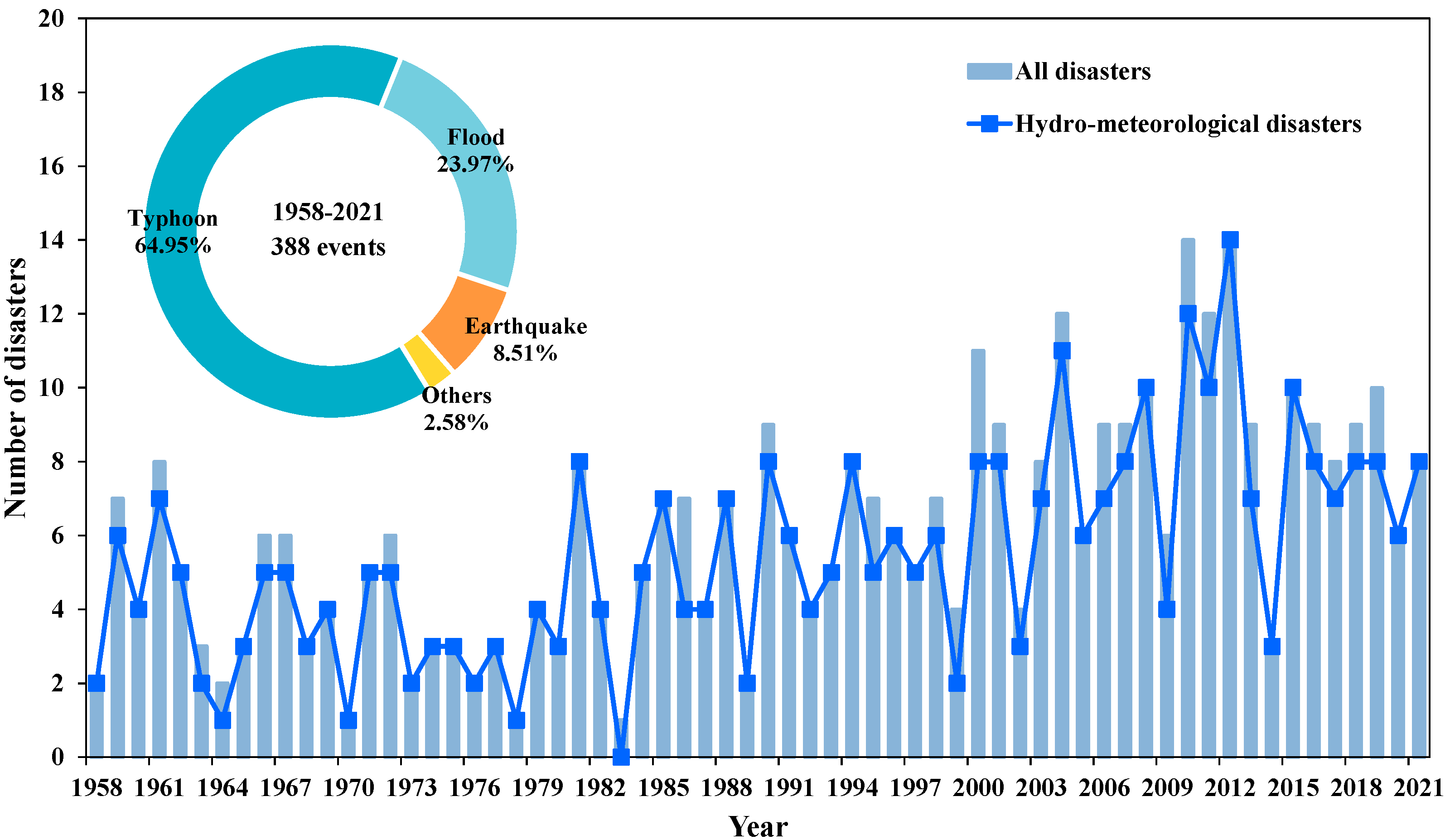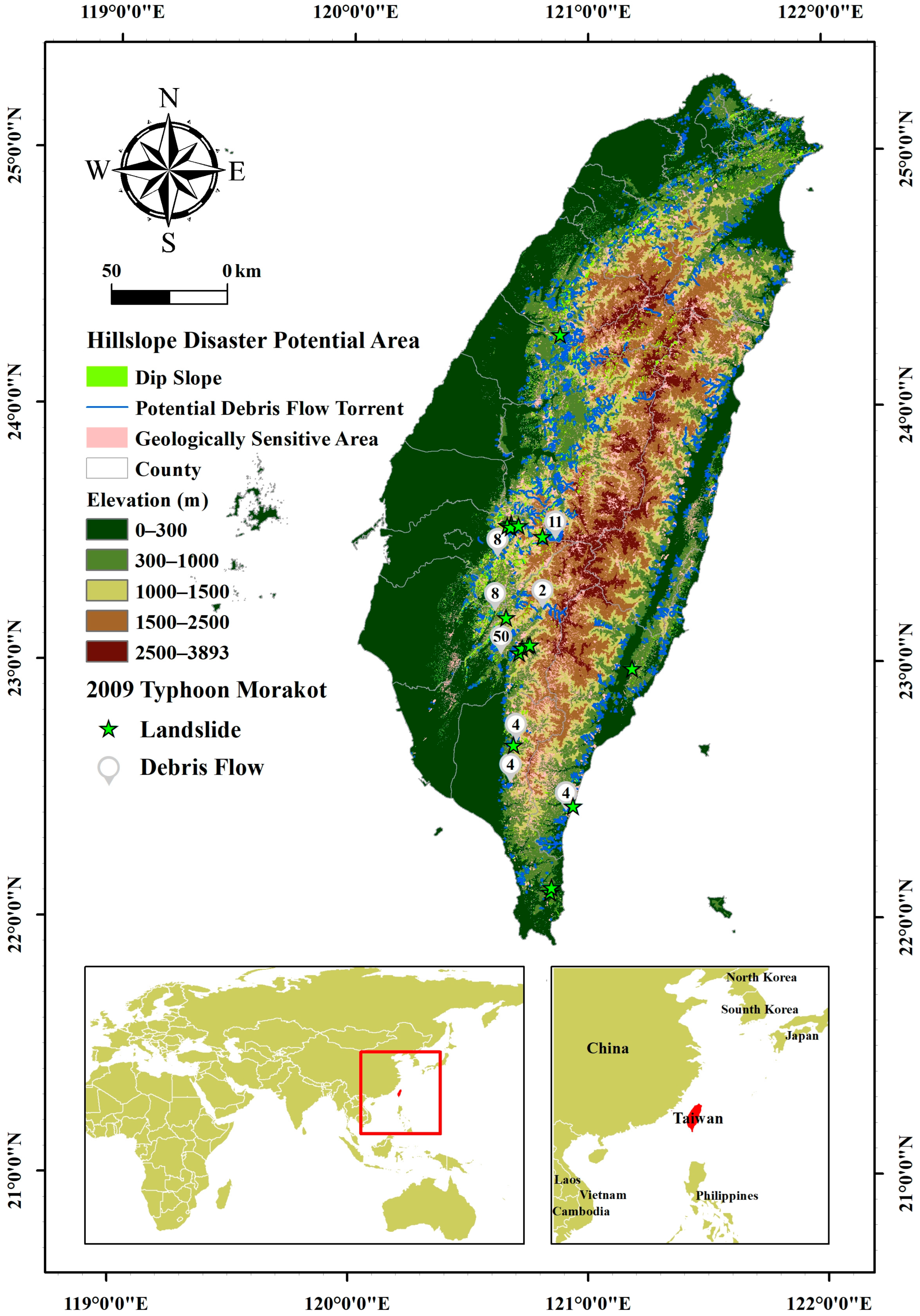Owing to active orogenic movement and the monsoon climate, rainfall-induced landslide disasters often occur in Taiwan. Hence, hillslope hydrology and stability have received considerable research attention. However, it remains difficult to accurately estimate the duration and consequences of hillslope instability induced by hillslope hydrology. Research on hillslope hydrology and stability is complicated by spatial heterogeneity, hydrological processes operating at various scales, spatiotemporal evolution, and geomorphological properties. Recent advances in critical zone science have provided an approach to extend geoscience studies. The “deep coupling” concept is essential for integrating physical, chemical, and biological processes on various spatiotemporal scales and for providing a macro and unified framework for evaluating internal properties and processes.
- hillslope hydrology
- critical zone science
- landslide
- slope stability
1. Introduction
2. Background of Hillslope Hydrology and Stability in Taiwan


References
- Jakob, M.; Hungr, O.; Jakob, D.M. Debris-Flow Hazards and Related Phenomena; Springer: Berlin, Germany, 2005.
- Tsou, C.-Y.; Feng, Z.-Y.; Chigira, M. Catastrophic landslide induced by Typhoon Morakot, Shiaolin, Taiwan. Geomorphology 2011, 127, 166–178.
- Chang, K.T.; Chiang, S.H. An integrated model for predicting rainfall-induced landslides. Geomorphology 2009, 105, 366–373.
- Wu, C.H.; Chen, S.C. Determining landslide susceptibility in Central Taiwan from rainfall and six site factors using the analytical hierarchy process method. Geomorphology 2009, 112, 190–204.
- Shou, K.-J.; Yang, C.-M. Predictive analysis of landslide susceptibility under climate change conditions—A study on the Chingshui River Watershed of Taiwan. Eng. Geol. 2015, 192, 46–62.
- Lin, S.; Ke, M.; Lo, C. Evolution of landslide hotspots in Taiwan. Landslides 2017, 14, 1491–1501.
- Lin, G.W.; Chen, H. The relationship of rainfall energy with landslides and sediment delivery. Eng. Geol. 2012, 125, 108–118.
- Chen, Y.C.; Chang, K.T.; Chiu, Y.J.; Lau, S.M.; Lee, H.Y. Quantifying rainfall controls on catchment-scale landslide erosion in Taiwan. Earth Surf. Process. Landf. 2013, 38, 372–382.
- Chen, C.-W.; Saito, H.; Oguchi, T. Rainfall intensity–duration conditions for mass movements in Taiwan. Prog. Earth Planet. Sci. 2015, 2, 14.
- Chang, J.M.; Chen, H.; Jou, B.J.D.; Tsou, N.C.; Lin, G.W. Characteristics of rainfall intensity, duration, and kinetic energy for landslide triggering in Taiwan. Eng. Geol. 2017, 231, 81–87.
- Chen, C.W.; Oguchi, T.; Hayakawa, Y.S.; Saito, H.; Chen, H. Relationship between landslide size and rainfall conditions in Taiwan. Landslides 2017, 14, 1235–1240.
- Chen, C.-W.; Hung, C.; Lin, G.-W.; Liou, J.-J.; Lin, S.-Y.; Li, H.-C.; Chen, Y.-M.; Chen, H. Preliminary establishment of a mass movement warning system for Taiwan using the soil water index. Landslides 2022, 19, 1779–1789.
- Liang, W.-L. Dynamics of pore water pressure at the soil–bedrock interface recorded during a rainfall-induced shallow landslide in a steep natural forested headwater catchment, Taiwan. J. Hydrol. 2020, 587, 125003.
- Sidle, R.C.; Bogaard, T.A. Dynamic earth system and ecological controls of rainfall-initiated landslides. Earth Sci. Rev. 2016, 159, 275–291.
- Lu, N.; Godt, J.W. Hillslope Hydrology and Stability; Cambridge University Press: New York, NY, USA, 2013.
- Coutinho, R.Q.; Silva, M.M.; Santos, A.N.d.; Lacerda, W.A. Geotechnical Characterization and Failure Mechanism of Landslide in Granite Residual Soil. J. Geotech. Geoenviron. Eng. 2019, 145, 05019004.
- Iverson, R.M. Landslide triggering by rain infiltration. Water Resour. Res. 2000, 36, 1897–1910.
- Marc, O.; Stumpf, A.; Malet, J.-P.; Gosset, M.; Uchida, T.; Chiang, S.-H. Initial insights from a global database of rainfall-induced landslide inventories: The weak influence of slope and strong influence of total storm rainfall. Earth Surf. Dyn. 2018, 6, 903–922.
- Wu, L.; Huang, R.; Li, X. Hydro-Mechanical Analysis of Rainfall-Induced Landslides; Science Press: Beijing, China, 2020.
- Bogaard, T.A.; Greco, R. Landslide hydrology: From hydrology to pore pressure. Wiley Interdiscip. Rev. Water 2016, 3, 439–459.
- Brantley, S.L.; Goldhaber, M.B.; Ragnarsdottir, K.V. Crossing disciplines and scales to understand the critical zone. Elements 2007, 3, 307–314.
- National Research Council. Basic Research Opportunities in Earth Science; National Academies Press: Washington, DC, USA, 2001; p. 168.
- Anderson, S.P.; von Blanckenburg, F.; White, A.F. Physical and chemical controls on the critical zone. Elements 2007, 3, 315–319.
- Lin, H.S. Earth′s Critical Zone and hydropedology: Concepts, characteristics, and advances. Hydrol. Earth Syst. Sci. 2010, 14, 25.
- Amundson, R.; Richter, D.D.; Humphreys, G.S.; Jobbágy, E.G.; Gaillardet, J. Coupling between biota and earth materials in the critical zone. Elements 2007, 3, 327–332.
- Li, Y.H. Denudation of Taiwan island since the Pliocene epoch. Geology 1976, 4, 105–107.
- Willett, S.D.; Fisher, D.; Fuller, C.; En-Chao, Y.; Chia-Yu, L. Erosion rates and orogenic-wedge kinematics in Taiwan inferred from fission-track thermochronometry. Geology 2003, 31, 945–948.
- Shieh, S. User’s Guide for Typhoon Forecasting in the Taiwan Area (VIII); Central Weather Bureau: Taipei, Taiwan, 2000.
- Chen, C.-S.; Chen, Y.-L. The Rainfall Characteristics of Taiwan. Mon. Weather Rev. 2003, 131, 1323–1341.
- Henny, L.; Thorncroft, C.D.; Hsu, H.-H.; Bosart, L.F. Extreme Rainfall in Taiwan: Seasonal Statistics and Trends. J. Clim. 2021, 34, 4711–4731.
- Dadson, S.J.; Hovius, N.; Chen, H.; Dade, W.B.; Hsieh, M.-L.; Willett, S.D.; Hu, J.-C.; Horng, M.-J.; Chen, M.-C.; Stark, C.P. Links between erosion, runoff variability and seismicity in the Taiwan orogen. Nature 2003, 426, 648–651.
- National Fire Agency, M.O.I. Natural Disaster Statistics. 2022. Available online: https://www.nfa.gov.tw/pro/index.php?code=list&ids=385 (accessed on 1 February 2022).
- Wu, C.-H.; Chen, S.-C.; Chou, H.-T. Geomorphologic characteristics of catastrophic landslides during typhoon Morakot in the Kaoping Watershed, Taiwan. Eng. Geol. 2011, 123, 13–21.
- Chang, P.Y.; Chen, C.C.; Chang, S.K.; Wang, T.B.; Wang, C.Y.; Hsu, S.K. An investigation into the debris flow induced by Typhoon Morakot in the Siaolin Area, Southern Taiwan, using the electrical resistivity imaging method. Geophys. J. Int. 2012, 188, 1012–1024.
- Kuo, Y.-S.; Tsai, Y.-J.; Chen, Y.-S.; Shieh, C.-L.; Miyamoto, K.; Itoh, T. Movement of deep-seated rainfall-induced landslide at Hsiaolin Village during Typhoon Morakot. Landslides 2013, 10, 191–202.
- Wu, J.-H.; Chen, J.-H.; Lu, C.-W. Investigation of the Hsien-du-Shan rock avalanche caused by typhoon Morakot in 2009 at Kaohsiung county, Taiwan. Int. J. Rock Mech. Min. Sci. 2013, 60, 148–159.
- Chen, J.-C.; Chuang, M.-R. Discharge of landslide-induced debris flows: Case studies of Typhoon Morakot in southern Taiwan. Nat. Hazards Earth Syst. Sci. 2014, 14, 1719.
- Wu, C.-H.; Chen, S.-C.; Feng, Z.-Y. Formation, failure, and consequences of the Xiaolin landslide dam, triggered by extreme rainfall from Typhoon Morakot, Taiwan. Landslides 2014, 11, 357–367.
- Lin, C.-H.; Lin, M.-L. Evolution of the large landslide induced by Typhoon Morakot: A case study in the Butangbunasi River, southern Taiwan using the discrete element method. Eng. Geol. 2015, 197, 172–187.
- Tsai, F.; Hwang, J.-H.; Chen, L.-C.; Lin, T.-H. Post-disaster assessment of landslides in southern Taiwan after 2009 Typhoon Morakot using remote sensing and spatial analysis. Nat. Hazards Earth Syst. Sci. 2010, 10, 2179.
- Lin, C.-W.; Chang, W.-S.; Liu, S.-H.; Tsai, T.-T.; Lee, S.-P.; Tsang, Y.-C.; Shieh, C.-L.; Tseng, C.-M. Landslides triggered by the 7 August 2009 Typhoon Morakot in southern Taiwan. Eng. Geol. 2011, 123, 3–12.
- Chen, C.-Y. Landslide and debris flow initiated characteristics after typhoon Morakot in Taiwan. Landslides 2016, 13, 153–164.
- Peng, S.-H.; Lu, S.-C. FLO-2D simulation of mudflow caused by large landslide due to extremely heavy rainfall in southeastern Taiwan during Typhoon Morakot. J. Mt. Sci. 2013, 10, 207–218.
- Li, H.-C.; Hsieh, L.-S.; Chen, L.-C.; Lin, L.-Y.; Li, W.-S. Disaster investigation and analysis of Typhoon Morakot. J. Chin. Inst. Eng. 2014, 37, 558–569.
- Fan, M.-F. Disaster governance and community resilience: Reflections on Typhoon Morakot in Taiwan. J. Environ. Plann. Manag. 2015, 58, 24–38.
- Hsu, M.; Howitt, R.; Miller, F. Procedural vulnerability and institutional capacity deficits in post-disaster recovery and reconstruction: Insights from Wutai Rukai experiences of Typhoon Morakot. Hum. Organ. 2015, 74, 308–318.
- Wei, L.-W.; Lee, C.-F.; Huang, C.-M.; Huang, W.-K.; Lin, H.-H.; Chi, C.-C. A Prelimilary Study of the Rainfall Threshold and Early Warning System for Landslide in Taiwan, in Engineering Geology for Society and Territory-Volume 2; Springer: Cham, Switzerland, 2015; pp. 1571–1574.
- Wei, L.-W.; Huang, C.-M.; Chen, H.; Lee, C.-T.; Chi, C.-C.; Chiu, C.-L. Adopting the I 3-R 24 rainfall index and landslide susceptibility for the establishment of an early warning model for rainfall-induced shallow landslides. Nat. Hazards Earth Syst. Sci. 2018, 18, 1717–1733.
- Lu, A.; Haung, W.-K.; Lee, C.-F.; Wei, L.-W.; Lin, H.-H.; Chi, C.-C. Combination of Rainfall Thresholds and Susceptibility Maps for Early Warning Purposes for Shallow Landslides at Regional Scale in Taiwan. In Workshop on World Landslide Forum; Springer: Berlin/Heidelberg, Germany, 2020.
- Lin, G.-W.; Kuo, H.-L.; Chen, C.-W.; Wei, L.-W.; Zhang, J.-M. Using a tank model to determine hydro-meteorological thresholds for large-scale landslides in Taiwan. Water 2020, 12, 253.
- Chen, H.-W.; Chen, C.-Y. Warning Models for Landslide and Channelized Debris Flow under Climate Change Conditions in Taiwan. Water 2022, 14, 695.
- Tsai, Y.-J.; Syu, F.-T.; Shieh, C.-L.; Chung, C.-R.; Lin, S.-S.; Yin, H.-Y. Framework of Emergency Response System for Potential Large-Scale Landslide in Taiwan. Water 2021, 13, 712.
- Lee, C.-T. Review and Prospect on Landslide and Debris Flow Hazard Analysis. Taiwan Public Eng. J. 2009, 5, 1–29. (In Chinese)
- Bachmair, S.; Weiler, M. New Dimensions of Hillslope Hydrology. In Forest Hydrology and Biogeochemistry: Synthesis of Past Research and Future Directions; Levia, D.F., Carlyle-Moses, D., Tanaka, T., Eds.; Springer Netherlands: Dordrecht, The Netherlands, 2011; pp. 455–481.
